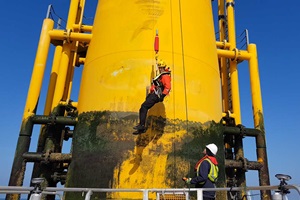 Ørsted has acquired a 22.5% share in Pict Offshore, the Scottish developer of the Get Up Safe (GUS) system. The GUS system, developed in partnership between Ørsted and Pict Offshore, is a motion compensated hoist solution that enables technicians to safely transfer between small moving vessels and offshore wind turbines.
Ørsted has acquired a 22.5% share in Pict Offshore, the Scottish developer of the Get Up Safe (GUS) system. The GUS system, developed in partnership between Ørsted and Pict Offshore, is a motion compensated hoist solution that enables technicians to safely transfer between small moving vessels and offshore wind turbines. Using this technology means that technicians will no longer have to step from a moving boat onto a ladder and then climb (sometimes over 20 metres) to reach the base of the turbine. Instead they can clip onto the system and be safely and effortlessly hoisted up to the turbine base directly from the boat. The system’s motion compensation capability means that the hoist automatically adjusts the line position to take account of the boats movements so that even in periods of high and varying wave heights, there is no danger of collision between the technician and the boat. In addition, the technology removes the need for external access ladders on the turbines. The technology is patent-protected and in the final stages of development. More than 1,600 successful hoists have already been conducted at Ørsted sites as part of the testing process. Pict Offshore is a spin off from height safety innovator Limpet Technology and is headquartered in Fife in Scotland.










